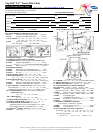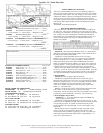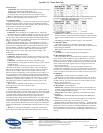
Top End
®
T-5
™
Tennis Elite Chair
Invacare Corporation
www.invacare.com
TOP END
Sports and Recreation Products
4501 63
rd
Circle North
Pinellas Park, FL USA
33781-5914
All rights reserved. Trademarks are identified by the symbols ™ and ®. All trademarks are owned by or licensed to
Invacare Corporation unless otherwise noted.
Spinergy is a registered trademark of Spinergy, Inc. Sun is a registered trademark of Sun Components Inc.
Kenda is a registered trademark of Kenda Rubber Industrial Co. Ltd.
Specifications and prices are subject to change without notification.
©2009 Invacare Corporation Form No. 05-061 Rev 0109
Page
3 of 3
4. Footrest Type:
Footnote #4: Recessed Footrest was also known as T-4 Style. Footrest
Width is approximately Seat Width minus (-) 4".
Footnote #5: Not available for Standard Tubular Footrest.
(A) Compare user’s existing footrest to those in diagram on pg.1.
(B) For an individual’s first sports wheelchair, the Recessed Footrest
provides the most adjustability. (See footnotes 4 & 5).
6. Front Frame Angle:
(A) Examine the end user’s existing chair. Selecting 90° will position the
Front Frame/ Footrest vertical. Selecting 85° will angle the Front Frame
/Footrest towards the front of the chair. Selecting 100° will angle the Front
Frame/ Footrest towards the rear of the chair.
(B) 85° is a conservative selection.
7 & 8. Seat Height Front / Rear:
Footnote #6: Rear Seat Height: 13" available with 24" wheels only.
(A) Measure the Front and Rear Seat Heights as shown in side view page
1. Use a tape measure to estimate the amount of change desired. Players
who have more ability commonly prefer higher Rear Seat Heights (greater
than 19"). Players who have less ability commonly prefer lower Rear Seat
Heights. (less than 18"). (See footnote #6)
(B) Rear Seat Height typically plays a more significant role in chair
performance than Front Seat Height. It is recommended for inexperienced
end users to try existing wheelchairs to understand the difference between
Rear Seat Heights. Taller Rear Seat Heights enable users to reach higher,
but in most cases reduce their mobility. Likewise, shorter Rear Seat
Heights reduce the user’s reach, while improving their mobility. (See
footnote #6)
9. Axle Position (Center of Gravity):
Footnote #7: Measure the user’s exhisting chair from the Front of the
Backpost, horizontally (as shown in side view pg 1), to the center of the
rear axle.
Footnote #8: Adjustable Center of Gravity: Non-folding, angle
adjustable backrest. If side guards are desired, Clamp-on style is the only
compatible option.
(A) The two largest contributors to the responsiveness of a sports
wheelchair are the frame’s Axle Position and the “sag” in the upholstery.
Both of these contributors determine where the user’s body is positioned
relative to the rear wheels. When a Fixed (welded in this case) Axle
Position is chosen, the upholstery can be expected to provide roughly 1" to
1½" of adjustment. If more adjustment is found to be required, additional
width back upholstery can be purchased through Top End customer service.
Choosing an Adjustable Center of Gravity range (shown on pg.1), adds an
additional 2" of adjustment to the upholstery (1"- 1½"). There are more
side guard options currently available with a fixed Axle position. (See
footnote #7 & 8)
(B) Choosing an Adjustable Center of Gravity of 3" to 5" provides a
good range for new users. (See footnotes #7 & 8)
10. Caster Position
(A) If the existing sports wheelchair present is not a Top End product, it
is recommended to specify a ‘Front to Wall’ dimension. The Front to Wall
dimension is intended to identify the current length of the user’s wheelchair.
To measure Front to Wall, position the leading edge of the existing
wheelchair directly towards a Wall (see page 1). Then, measure
horizontally from the Wall to the Front of the backrest. Use a tape measure
to estimate the amount of change desired. ½" sizes are acceptable. When
using Front to Wall, ¾" is the standard distance from the Wall to the Caster
Center. Experienced Top End users may prefer using the more traditional
measurement, Wheel Base. The Wheel Base measurement does not involve
a wall.
(B) When an existing sports wheelchair is not present, a conservative
Front to Wall measurement can be determined using the conversion chart:
If the person filling out the order form is more familiar with the traditional
measurement: Wheel Base, then following conversion chart applies:
13. Caster Center to Center:
Footnote #9: For Tubular Style footrests, Caster Center to Center
should be at least 5" greater than the Footrest Width. For Recessed Style
footrest, Caster Center to Centers are not recommended to be less than
13".
(A) & (B) Use the defaults specified on page 1. (See footnote #9)
14. Anti-tip/5
th
Wheel:
(A) Examine existing sports wheelchair. Fixed single Anti-tip is
standard. The Telescoping option is removable and may be desired for ease
of transporting the wheelchair.
(B) Single Anti-tip is recommended as standard for this product.
15. Camber:
(A) & (B) 20° is a common request for tennis wheelchairs.
18. Rear Wheel Size, Options:
(A) Existing Wheel size can be determined by reading the side-wall of
the tire currently used or comparison with a wheel whose size is known.
Wheel size is a player preference. Larger sizes may provide faster overall
speed, but slower starts. Smaller size wheels may provide faster starts, but
slower overall speed. Choosing the end user’s existing wheel size is the
most conservative choice.
(B) Using the Chart above: For Tall seat heights, 26"(590)’s are
recommended. For Medium, 25"(559)’s are recommended. And for Low,
24"(540)’s are recommended. Tip: If the end user has an everyday chair, it
may be convenient to choose the same size wheels on the new sports chair.
19. Pushrims:
Footnote #10: Titanium pushrims not available in 700C
(A) Std. mount vs. Close mount is a personal preference item. If Close
mount is desired, users can check the ‘Cut Tabs’ box to have the excess of
the Tabs removed. The conservative choice is to order what the user has
currently. (See footnote #10)
(B) Standard mount is a conservative choice.
21. Side Guards: (refer to diagrams)
Footnote #11: When Fixed Axle position chosen, all Side Guards are
available. When Adjustable Center of Gravity chosen, Clamp-on Fixed
Style are the only available side guards.
Footnote #12: Carbon Fiber Side Guards not available with Tapered
Seat Widths.
Footnote #13: Welded tube Side Guards will reduce Seat Widths by ½"
each side.
(A) If Side Guards are desired, measure the height of the existing Side
Guards from top of seat frame. (See footnotes #11, 12 &13)
(B) Side Guards are common for sports wheelchairs. All Non-Welded
Side Guards are removable. If the end user is not comfortable with the side
guards, they can always be taken off. Welded Side Guards are permanent,
and are intended for the advanced user. For Rear Seat heights above 19", 7"
above the seat frame is a conservative Side Guard height. (See footnotes #11,
12 &13)





